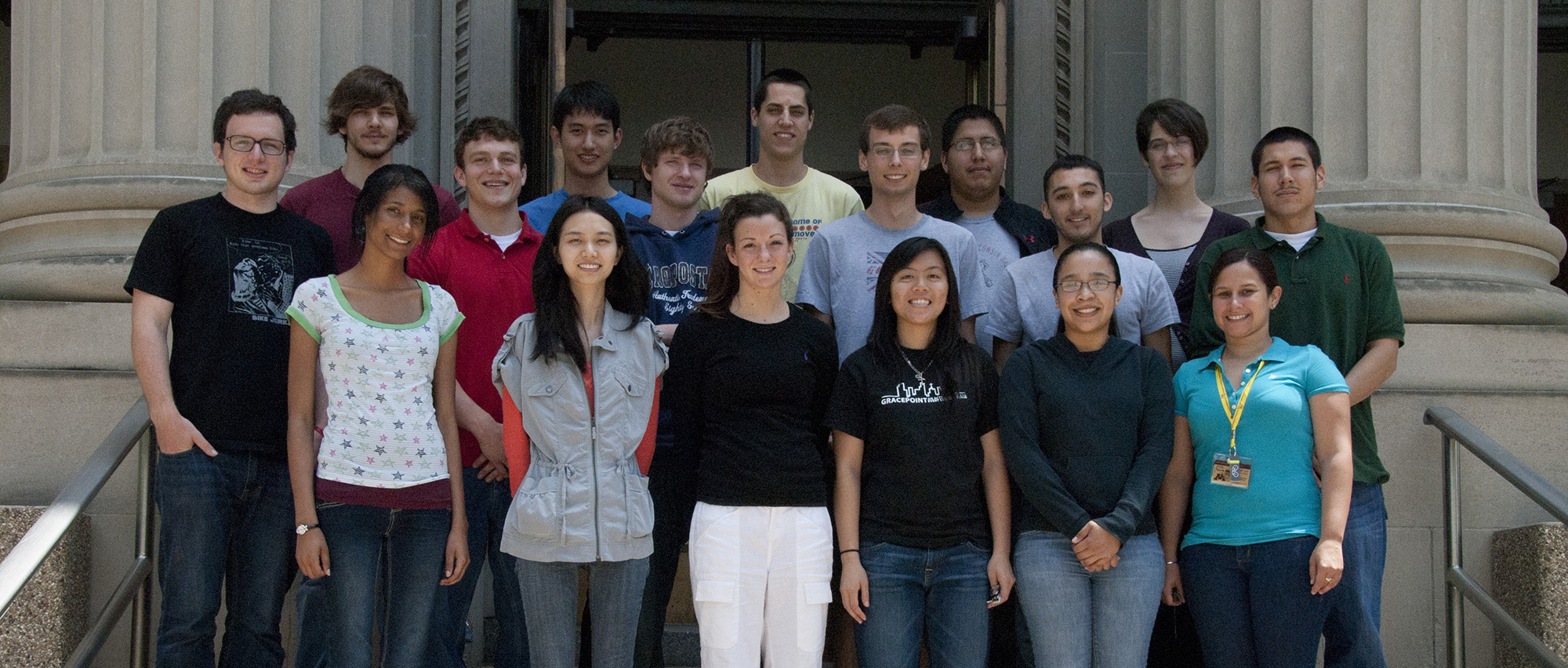

Home Institution: University of Michigan - Dearborn
Major/Minor: Physics
MRSEC Mentor: Paul Crowell
Studies of Spin Transport in Rubrene Based Organic Spin Valves
Organic semiconductor based transistors possess properties which make their use desirable in charge transport devices. In addition to charge transport, the transport of spins could also be incorporated. The physics underlying spin transport in organic based devices is still not well understood. The properties that determine the lengthscales that spins can be transported before losing their spin polarization must be better understood to pave the way for technological applications. The goal of this research is to fabricate lateral organic-based field effect transistors (OFETs) to study charge and spin transport. The lateral spin devices employ rubrene, which can be synthesized with a higher carrier mobility (µ ~ 10 cm2V-1s-1) than most organic semiconductors (µ ~ 10 cm2V-1s-1), making it a promising candidate for obtaining useful results.

Home Institution: University of Iowa
Major/Minor: Mechanical Engineering
MRSEC Mentor: Uwe Kortshagen
Self-Assembly of Silicon Nanowire Microstructures by Annealing of Silicon Nanoparticles
Silicon nanoparticles can be used for the assembly of nanowires for use in nanodevices and solar cells. Researchers are using multiple techniques such as etching to try to effectively synthesize ordered arrays of nanowires in order to increase the absorption of incident light for electrical conversion. However, the technical and financial challenges of ordering the arrays by etching make it impractical for mass manufacturing and reproduction. Thus, our lab uses a non-thermal plasma to create and deposit nanoparticles for the selfassembly of silicon nanowires. However the challenge is contracting these self-assembled structures to create thinner, ordered nanowires as the by annealing the deposited nanoparticles. The goal is to test different temperatures and annealing times, to see their effect on nanowire formation.
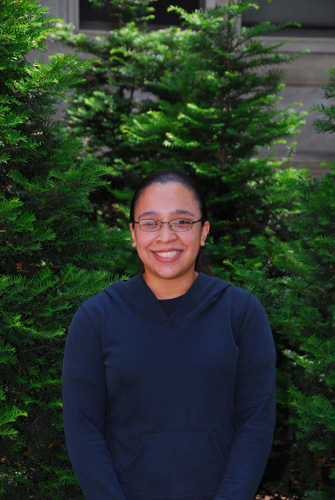
Home Institution: University of Texas Pan American
Major/Minor: Chemistry/Biology
MRSEC Mentor: Tim Lodge
Phase Behavior of Block Copolymer/Ionic Liquid Micelles
Block copolymers added to a solvent soluble for one block will self-assemble into micelles with a dense insoluble polymer core surrounded by a solvated soluble polymer shell. Ionic liquids have recently been explored as selective solvents for block copolymers because of their advantageous properties including high thermal and chemical stability. We take advantage of this stability to explore the phase diagram of the block copolymer micelles in solvent to higher temperatures using dynamic light scattering and fluorescence. The system studied was block copolymers of polystyrene-poly(methyl methacrylate) in 1-ethyl-3-methylimidazolium bis(trifluoromethylsulfonyl)amide ionic liquid. We were able to determine upper limits to critical micelle concentrations using fluorescence, but were unable to detect any critical micelle temperatures up to 200 °C in the range of concentrations with detectable scattering.
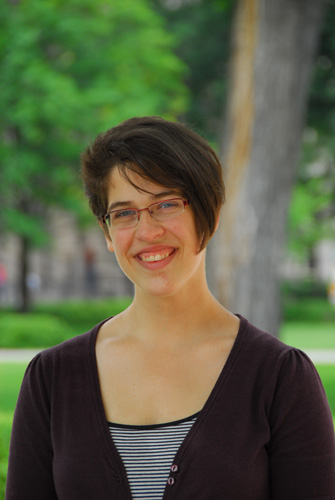
Home Institution: Mount Holyoke College
Major/Minor: Physics & Mathematics
MRSEC Mentor: Chris Leighton
Electrostatic modulation of the metal-insulator transition in La1-xSrxCoO3
The perovskite cobaltite La1-xSrxCoO3 (LSCO) is known to possess interesting magnetoelectronic properties, including magnetoelectronic phase separation, glassy ferromagnetism, spin state transitions, and metalinsulator transitions. Two factors in modulating these properties are charge carrier density and structural distortion. Electrostatic gating allows us to study the effects of charge modulation without the accompanying structural distortions introduced by chemical doping. In such experiments, ionic liquids have been widely used for their ability to induce high charge carrier densities as compared to traditional dielectrics. In this project, we use epitaxially grown LSCO films gated with an ion gel ([EMIM][TFSI] in a triblock copolymer matrix) to study the metal-insulator transition in LSCO in a four-terminal field effect transistor geometry by measuring resistivity as a function of temperature and gate voltage.
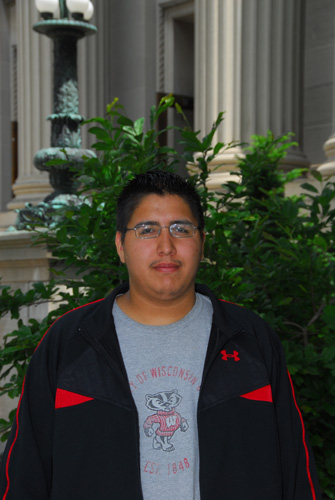
Home Institution: College of Menominee Nation
MRSEC Mentor: Victor Barocas
Quantifying Fiber Reorientation in a Simulated Collagen Network Model
Collagen is a ubiquitous protein used in tissue engineering and in the design of biomaterials since collagen fibrils and their networks play a primary structural role in mammalian tissues. However, the mechanics of collagen networks are still poorly understood. A better understanding of how these networks behave mechanically can be readily applied to solve current problems in biomedical engineering such as in creating more resilient tissue engineered heart valves and arteries. I used a fiber-based mechanical model for a type-I collagen network to simulate collagen deformation. I created a new computational network analysis tool to visualize how such networks reorganize under various loading conditions. Quantifying various fiber parameters in the collagen network can give us new insight into the underlying physics governing network deformation.
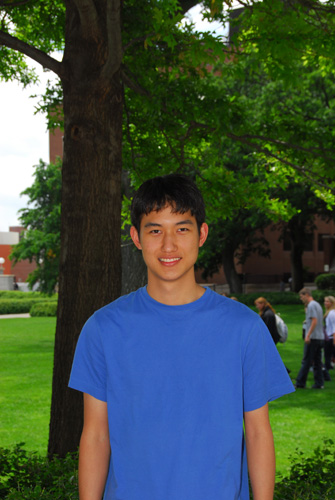
Home Institution: Washington University St. Louis
Major/Minor: Chemical Engineering
MRSEC Mentor: Frank Bates
Thermodynamic Behavior of poly(isoprene-b-lactide) Near the Frank-Kasper Sigma Phase
A diblock copolymer is a molecule that consists of two different homopolymer chains that are covalently linked together. This covalent link prevents macroscopic phase separation of the two homopolymer segments and instead leads to a tendency of these copolymers to self-assemble into a variety of ordered phases on a mesoscopic scale (5-50nm). The self-assembly of diblock copolymers has been studied extensively over recent decades. A product of these studies is the establishment of a universal phase behavior in high molecular weight diblock copolymers. However, a recently published report has presented the discovery of a new phase – the Frank-Kasper σ phase – in a low molecular weight poly(isoprene-b-lactide) polymer. Our project aims to explore the region of the thermodynamic phase diagram near the reported σ phase to determine range of compositions and molecular weights for which the σ phase is stable in this system. We will use living anionic polymerization to synthesize various poly(isoprene-b-lactide) diblock copolymers and characterize the molecular, mechanical, and thermodynamic properties of these copolymers using NMR spectroscopy, SEC, DSC, and rheological techniques.
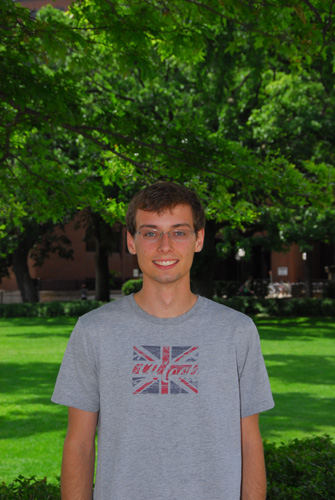
Home Institution: Texas A&M
Major/Minor: Chemical Engineering
MRSEC Mentor: Aaron Massari
Structural Changes in Annealed Organic Field-Effect Transistors
Thermal annealing can be used to improve the crystallinity of the polymer layer of an OFET at the interface between the polymer and the insulator, where the majority of the charge transport occurs. Our goal is to make the semiconducting polymer layer conduct charges as effectively as possible, by varying the annealing process used while examining the polymer layer. To accomplish this, we will monitor the thermal annealing process in-situ, using a combination of FTIR and UV-vis analysis to examine the structure of regio-regular poly(3- hexylthiophene) during heating and cooling. This data will be compared to electronic experiments measuring the charge mobility of the polymer layer on functionalized oFETs. By examining how the structure of the surface changes with temperature, we will gain an understanding of how the annealing process works to enhance charge mobility at the polymer-insulator interface.
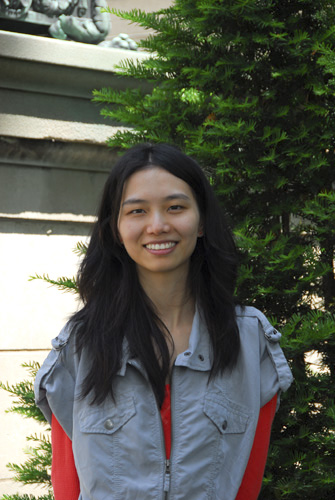
Home Institution: University of Texas Pan American
Major/Minor: Chemistry/Biology
MRSEC Mentor: Andreas Stein
3DOm Carbon for New Energy Absorption Application
Advanced energy absorption systems have recently been developed, in which external work is converted into stored energy by infiltrating nanoporous materials with liquid phases. The ability of the porous material to absorb energy depends on pore sizes and on the hydrophobic/hydrophilic interactions between the surface and the infiltrating liquid. In this project, three-dimensionally ordered mesoporous (3DOm) carbon is studied as a new material for energy storage. 3DOm carbon is synthesized by replication of 10-40nm silica nanoparticles. 3DOm materials in general have the property of highly interconnected pores and large surface areas. Various polymers and molecular precursors are used as the carbon sources to replicate silica spheres. The final product is highly porous carbon with large surface area with is ideal for mechanical energy absorption.

Home Institution: University of Puerto Rico at Humacao
Major/Minor: Industrial Chemistry
MRSEC Mentor: R. Lee Penn
Photocatalytic Activity of Metal Sulfide Nanoparticles
Presently, most of the energy consumed globally comes from the use of fossil fuels, namely oil, natural gas and coal. These sources of energy are nonrenewable resources. This project focuses on the synthesis and characterization of promising photovoltaic and photo-catalytic materials that are non-hazardous, cost efficient, made from abundant elements, and easy to fabricate. Sulfide nanoparticles were synthesized using transition metals like Cu, Zn and Tin (IV). The SHArK (Solar Hydrogen Activity Research Kit) system, a high throughput method to screen combinatorial libraries of materials, was used to characterize photocatalytic activity by quantifying water splitting. Results show that the copper and zinc sulfides have active area leading them to be the most promising materials for photocatalysis.
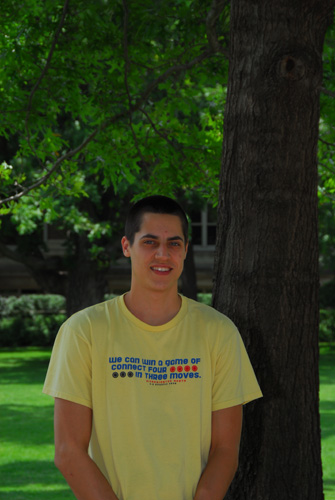
Home Institution: University of Cincinnati
Major/Minor: Physics
MRSEC Mentor: Jian-Ping Wang
Electrical Measurements of Dipole Coupled Nanomagnets
Logic devices are an integral part of technological infrastructure, and finding ways to make them smaller and less power-consuming are highly desired. One option uses magnetic quantum cellular automata (MQCA) devices for a non-volatile logic system. These devices can be made with magnetic tunnel junctions (MTJ) which can be high or low resistance, depending on the magnetic orientation of their magnetic layers. The integration of MTJs provides an interface between MQCA and other electronics in the infrastructure. In this work we demonstrate the strong effects of the individual size of the nanomagnets and the distance of separation between elements on the performance of the devices.
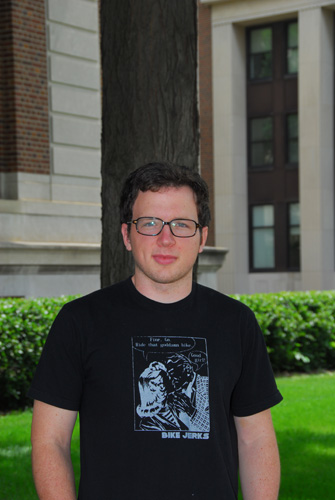
Home Institution: North Carolina State
Major/Minor: Chemical Engineering
MRSEC Mentor: Andre Mkhoyan
Optical Properties of PbSe Nanocrystal Monolayers
Lead selenide (PbSe) nanocrystals have shown promise for a variety of optoelectronic applications including photovoltaics due to the ease of colloidal synthesis and the ability to absorb light in the infrared region. The nanocrystals, often referred to as quantum dots (QDs), can be easily deposited onto a variety of substrates through simple solution-cast methods and in fact self-assemble into highly ordered hexagonally oriented monolayers. It has been previously shown that thin films of PbSe QDs can exhibit high carrier mobilities due to strong electronic coupling between the QDs; however, surfactants required for colloidal stability often decrease the conductivity of the thin films. We aim to further study the effect of inter-QD electronic interaction on the optical coupling between the QDs by using spectroscopic ellipsometry to determine the dielectric function of the PbSe monolayer and its dependence on parameters such as inter-QD spacing and surfactant identity.

Home Institution: University of Texas Pan American
Major/Minor: Mechanical Engineering
MRSEC Mentor: Eray Aydil
Auger Electron Spectroscopy of Carbon Nanofiber Reinforced Polymer Substrates Coated with Thin Metallic Films
Polystyrene Butadiene Copolymer (PSB) and High Density Polyethylene (HDPE) are being conducted in research to improve the Electromagnetic Interference Shielding Effectiveness (EMI SE) which will decrease the degradation of systems and improve system performance. Two methods are being used to improve the EMI SE of these polymers; Carbon nanofiber reinforcement and thin films deposition. In order to have maximum effectiveness for shielding, the thickness and type of material used is crucial. The Auger Electron Spectroscopy (AES) is a technique used to show a depth profile given by percentages of each element on the substrate as a function of time. With these results, imperfections of the amount of material on the substrate can be altered to improve the performance of shielding effectiveness against electromagnetic interference.
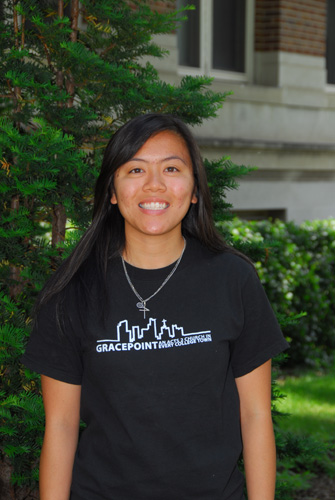
Home Institution: University of Texas at Austin
Major/Minor: Chemical Engineering
Separation of CO2/ Methane Gas Mixtures Using Diblock Copolymer Membranes
Carbon dioxide and methane gas separation in industrial natural gas processing is currently dominated by energy-intensive amine absorption technology. Membrane-based separation is an alternative, energy efficient process that also features small environmental footprint, low capital cost, and limited maintenance. However, implementation of synthetic membranes in the treatment of natural gas has been limited due to plasticization of the membrane and its resultant low selectivity. One solution may be the use of a block copolymer of bicontinuous nanostructure. In our efforts, we strive to synthesize and characterize a P(S-co- DVB)-b-PEO block copolymer in which the cross-linked phase restricts chain mobility of the more permeable PEO domain such that plasticization effects are negated and high selectivity of carbon dioxide over methane is maintained.

Home Institution: Grambling
Major/Minor: Chemistry
MRSEC Mentor: Chris Macosko
Investigating the End Effect Correction Factors for Rotational Viscometer Geometries
Concentric Cylinders are widely employed to measure shear viscosities of liquids whose microstructures require more than microseconds to equilibrate within a flow for complex solutions used in various technologies. The torque developed on both the inner or outer cylinders is very large and hence, the torque developed on the top and bottom ends of the fixed cylinder can be neglected. However, when the fluids cannot sustain their own weight, they must be contained in a cup thus exposing the bottom and/or top surfaces of the inner cylinder to fluid drag producing an end-effect. The goal of this work is to verify end effect correction factors for DIN Concentric cylinder rotational rheometer geometries in order to help provide guidelines for users on Rheometers.

Home Institution: Iowa State University
Major/Minor: Chemical Engineering
MRSEC Mentor: Ron Siegel
Engineering Multiblock Copolymers for the use of Drug Delivery
Block copolymers are composed of polymer subunits that are covalently bonded. In the present research, monomers are polymerized using RAFT, a relatively new living polymerization technique. We are presently synthesizing AB and BA diblock copolymers where the A block consists of N-Isopropylacrylamide (NIPAM) and the B block is a random copolymer of NIPAM and acrylic acid (AA). It was found in previous research that reversing the order of polymerization of the diblock alters properties of the copolymer in aqueous solutions. One hypothesis is that the RAFT chain transfer agent (CTA), a trithiocarbonate with a hydrophobic C12H25 tail, strongly influences phase behavior. To test this hypothesis the CTA will be removed and the effect of this operation on cloud points will be assessed.

Home Institution: University of Iowa
Major/Minor: Chemical Engineering/Mathematics
MRSEC Mentor: Dan Frisbie
Molecular Weight Dependence of poly(thienylene vinylene)/Fullerene Bulk Heterojunction Solar Cells
Bulk heterojunction (BHJ) solar cells made from conductive organic molecules have the potential to provide an inexpensive, clean and renewable source of energy for our society. Molecular weight (MW) is among the most important properties governing polymer behavior, yet the MW dependence of donor polymers in BHJ solar cells has received little attention. In order to gain a better understanding of this relationship, we have designed experiments to investigate the effect of MW on light absorption, phase behavior, and charge transport in BHJ cells. Completion of these experiments will give insight into the mechanisms by which donor MW affects solar cell performance and will allow for better designs and more informed choices of materials for polymer/fullerene BHJ solar cells.

Home Institution: University of Texas - Austin
Major/Minor: Chemical Engineering
MRSEC Mentor: Sang-Hyun Oh
Membrane receptor biosensing with black lipid membrane over plasmonic nanopore arrays
Microfluidic surface plasmon resonance (SPR) biosensors with surface-supported artificial lipid membrane are effective platforms for real-time label-free interrogation of membrane receptor-ligand combinations. Black lipid membrane (BLM) sensing is an analogous technique, but with free-standing membrane over nanopore array, with access to both sides of the bilayer. In addition to providing better simulation of biological membrane, the periodic nanopore array in BLM sensors engenders another favorable phenomenon, extraordinary optical transmission, which boosts light transmission at specific wavelengths mediated by the surface plasmons. Despite the advantages of BLM sensing, it is not frequently applied due to BLM fragility. A proposed solution to monitor bilayer stability and integrity is to incorporate potentiostat electrodes in the microfluidic chip. BLMs have characteristic dielectric properties and their capacitance values have been characterized through electrochemical impedance spectroscopy (EIS). My goal is to design a novel biosensor by combining SPR and EIS functionalities within a single microfluidic platform.

Home Institution: Robbinsdale Cooper
MRSEC Mentor: Dan Dahlberg
Quantitative Measurement of Diamagnetism and Paramagnetism of H2O, NaCl and CuSO4
The new science standards for Minnesota students now include an engineering component. However, chemistry teachers have difficulty bringing in engineering-based labs because of material hazards and costs. Additionally, students at the secondary level have not had the math required to tackle many engineering problems. This inquiry-based activity will address this issue by allowing teachers to engage their students in the investigation of the emptying of a variety of simple water tanks. The activity uses low-hazard, easily acquired, minimal cost materials that allow students to study the different variables that affect the process. Through graphical simplified mathematical analyses, students can predict and verify the emptying times of other containers.

Home Institution: Minneapolis Edison
MRSEC Mentor: Kevin Dorfman
The Tank Emptying Problem: A Classic Chemical Engineering Problem for the K12 Classroom
The new science standards for Minnesota students now include an engineering component. However, chemistry teachers have difficulty bringing in engineering-based labs because of material hazards and costs. Additionally, students at the secondary level have not had the math required to tackle many engineering problems. This inquiry-based activity will address this issue by allowing teachers to engage their students in the investigation of the emptying of a variety of simple water tanks. The activity uses low-hazard, easily acquired, minimal cost materials that allow students to study the different variables that affect the process. Through graphical simplified mathematical analyses, students can predict and verify the emptying times of other containers.
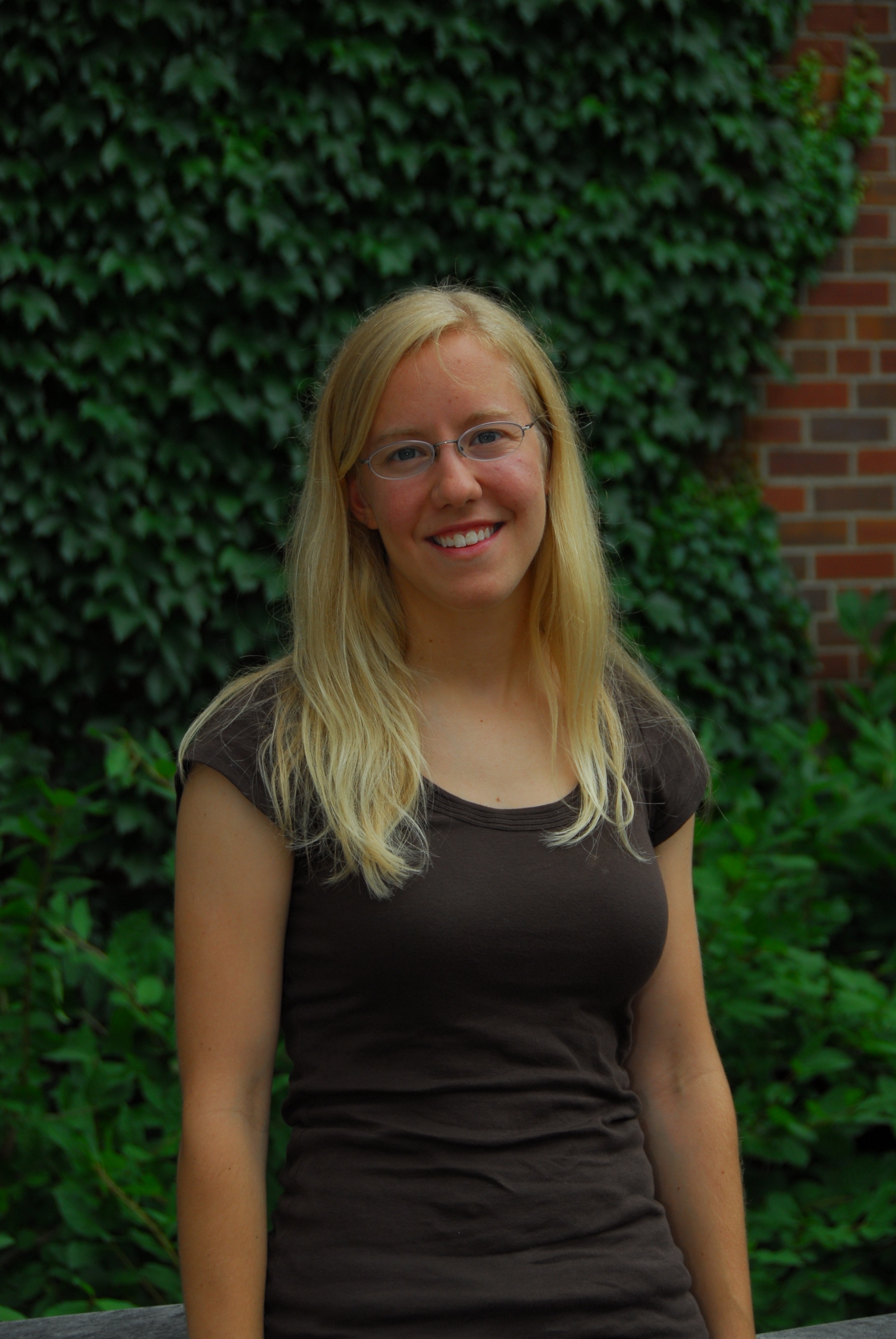
Home Institution: Bloomington Kennedy
MRSEC Mentor: Marc Hillmyer
Bioplastics for a High School Lab
Most K-12 teachers have minimal experience in the field of engineering, and Minnesota has recently adopted new standards for science and engineering. I have created a materials engineering lab suitable for a high school chemistry classroom. Students will create a bioplastic from starch and use a tensile test to compare how adding a different composite materials will affect the properties of the plastic. Because the plastic in this lab is made from renewable biomass sources, this also allows for a discussion on renewable materials and biodegradation. Students will discover that while a plastic derived from starch alone is inherently brittle, there are multiple ways to create more flexible materials with more desirable properties for many different applications.
UMN MRSEC
435 Amundson Hall, 421 Washington Ave. SE, Minneapolis, MN, 55455
P: 612-626-0713 | F: 612-626-7805